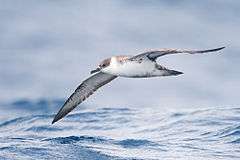Great shearwater
| Great shearwater | |
|---|---|
 | |
| Scientific classification | |
| Kingdom: | Animalia |
| Phylum: | Chordata |
| Class: | Aves |
| Order: | Procellariiformes |
| Family: | Procellariidae |
| Genus: | Ardenna |
| Species: | A. gravis |
| Binomial name | |
| Ardenna gravis (O'Reilly, 1818) | |
| Synonyms | |
|
Procellaria gravis O'Reilly, 1818 | |
The great shearwater (Ardenna gravis; formerly Puffinus gravis) is a large shearwater in the seabird family Procellariidae. Ardenna was first used to refer to a seabird by Italian naturalist Ulisse Aldrovandi in 1603, and gravis is Latin for "heavy".[2]
The great shearwater's relationships are unclear. It belongs in the group of large species that have been separated as genus Ardenna (Penhallurick & Wink 2004); within these, it might be allied with the other black-billed, blunt-tailed species, the short-tailed shearwater and especially the sooty shearwater (Austin 1996, Heidrich et al. 1998). Alternatively (Austin 1996, Austin et al. 2004), it could be a monotypic subgenus (Ardenna sensu stricto), an Atlantic representative of the light-billed Hemipuffinus group (pink-footed shearwater and flesh-footed shearwater).
This species breeds on Nightingale Island, Inaccessible Island, Tristan da Cunha, and Gough Island. It is one of only a few bird species to migrate from breeding grounds in the Southern Hemisphere to the Northern Hemisphere, the normal pattern being the other way round. This shearwater nests in large colonies, laying one white egg in a small burrow or in the open grass. These nests are visited only at night to avoid predation by large gulls.
This shearwater, like the sooty shearwater, follows a circular route, moving up the eastern seaboard of first South and then North America, before crossing the Atlantic in August. It can be quite common off the south-western coasts of Great Britain and Ireland before heading back south again, this time down the eastern littoral of the Atlantic.

This bird has the typically "shearing" flight of the genus, dipping from side to side on stiff wings with few wingbeats, the wingtips almost touching the water. Its flight is powerful and direct, with wings held stiff and straight.
This shearwater is 43–51 cm in length with a 105–122 cm wingspan. It is identifiable by its size, dark upperparts, and underparts white except for a brown belly patch and dark shoulder markings. It has a black cap, black bill, and a white "horseshoe" on the base of the tail. The stiff flight, like a large Manx shearwater, is also distinctive. The only other large shearwater in its range is the all-dark sooty shearwater.
The great shearwater feeds on fish and squid, which it catches from the surface or by plunge-diving. It readily follows fishing boats, where it indulges in noisy squabbles. This is a gregarious species, which can be seen in large numbers from ships or appropriate headlands. They have a piercing eeyah cry usually given when resting in groups on the water.
References
- ↑ BirdLife International (2012). "Ardenna gravis". IUCN Red List of Threatened Species. Version 2013.2. International Union for Conservation of Nature. Retrieved 26 November 2013.
- ↑ Jobling, James A (2010). The Helm Dictionary of Scientific Bird Names. London: Christopher Helm. pp. 40, 54, 178. ISBN 978-1-4081-2501-4.
- Austin, Jeremy J. (1996): Molecular Phylogenetics of Puffinus Shearwaters: Preliminary Evidence from Mitochondrial Cytochrome b Gene Sequences. Molecular Phylogenetics and Evolution 6(1): 77–88. doi:10.1006/mpev.1996.0060 (HTML abstract)
- Austin, Jeremy J.; Bretagnolle, Vincent & Pasquet, Eric (2004): A global molecular phylogeny of the small Puffinus shearwaters and implications for systematics of the Little-Audubon's Shearwater complex. Auk 121(3): 847–864. DOI: 10.1642/0004-8038(2004)121[0847:AGMPOT]2.0.CO;2 HTML abstract
- Bull, John L.; Farrand, John Jr.; Rayfield, Susan & National Audubon Society (1977): The Audubon Society field guide to North American birds, Eastern Region. Alfred A. Knopf, New York. ISBN 0-394-41405-5
- Harrison, Peter (1987): Seabirds of the world : a photographic guide. Princeton University Press, Princeton. ISBN 0-691-01551-1
- Heidrich, Petra; Amengual, José F. & Wink, Michael (1998): Phylogenetic relationships in Mediterranean and North Atlantic shearwaters (Aves: Procellariidae) based on nucleotide sequences of mtDNA. Biochemical Systematics and Ecology 26(2): 145–170. doi:10.1016/S0305-1978(97)00085-9 PDF fulltext
- Penhallurick, John & Wink, Michael (2004): Analysis of the taxonomy and nomenclature of the Procellariformes based on complete nucleotide sequences of the mitochondrial cytochrome b gene. Emu 104(2): 125-147. doi:10.1071/MU01060 (HTML abstract)
External links
| Wikimedia Commons has media related to Puffinus gravis. |
